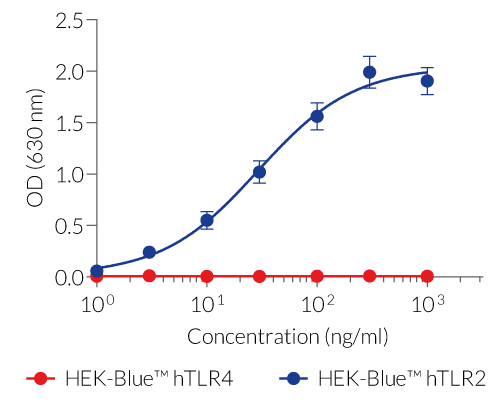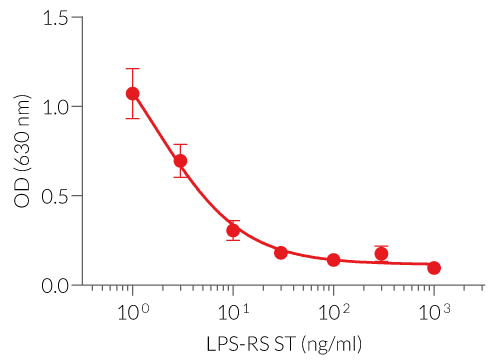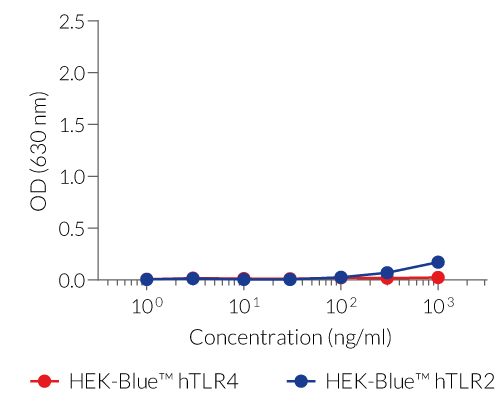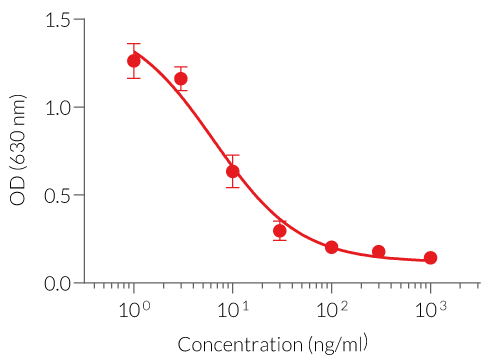LPS-RS
| Product | Unit size | Cat. code | Docs. | Qty. | Price | |
|---|---|---|---|---|---|---|
|
LPS-RS TLR4 Antagonist and TLR2 agonist - LPS from R. sphaeroides |
Show product |
5 mg |
tlrl-rslps
|
|
||
|
LPS-RS Ultrapure TLR4 Antagonist - Ultrapure LPS from R. sphaeroides |
Show product |
1 mg |
tlrl-prslps
|
|
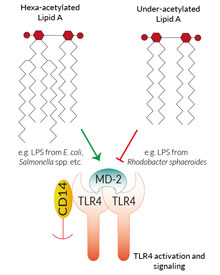
TLR4 antagonist activity of LPS-RS
LPS from Rhodobacter sphaeroides
Lipopolysaccharide from the photosynthetic bacterium Rhodobacter sphaeroides (LPS-RS) is a potent antagonist of toxic hexa-acylated LPS in human and murine cells [1]. It also prevents LPS-induced shock in mice [1]. Complete competitive inhibition of LPS activity is possible at a 100-fold excess of the antagonist. LPS-RS does not induce TLR4 signaling but is detected by the LAL assay, the standard endotoxin detection assay.
Mode of action:
LPS-RS is penta-acylated, and like other under-acylated LPS, appears to use at least two distinct mechanisms to block LPS-dependent activation of Toll-like receptor 4 (TLR4). The primary mechanism consists of direct competition between under-acylated LPS and hexa-acylated LPS for the same binding site on MD-2, while the secondary mechanism involves the ability of under-acylated LPS-MD-2 complexes to inhibit the TLR4 agonist activity of hexa-acylated LPS-MD-2 complexes [2-5].
InvivoGen provides LPS-RS with two grades of purity:
- LPS-RS is a standard lipopolysaccharide (LPS) preparation extracted by a phenol-water mixture. It inhibits TLR4 activity, however, as LPS-RS contains other bacterial components, such as lipoproteins, it activates TLR2.
- LPS-RS Ultrapure is extracted by successive enzymatic hydrolysis steps and purified by the previously described phenol-TEA-DOC extraction protocol [6]. This process removes contaminating lipoproteins, and therefore LPS-RS Ultrapure does not activate TLR2 while retaining the ability to inhibit TLR4 activity.
![]() Learn more about TLR4 and its co-receptors
Learn more about TLR4 and its co-receptors
References:
1. Qureshi, N. et al., 1999. Nontoxic RsDPLA as a potent antagonist of toxic lipopolysaccharide. p. 687-98. In: Brade H., Opal S. M., Vogel S. N., and Morrison D. C., eds. Endotoxin in Health and Disease. Marcel Dekker, New York.
2. Coats SR. et al., 2005. MD-2 mediates the ability of tetra-acylated and penta-acylated lipopolysaccharides to antagonize Escherichia coli lipopolysaccharide at the TLR4 signaling complex. J Immunol. 175(7):4490-8.
3. Teghanemt A. et al., 2005. Molecular basis of reduced potency of underacylated endotoxins. J Immunol. 175(7):4669-76.
4. Visintin A. et al., 2005. Pharmacological inhibition of endotoxin responses is achieved by targeting the TLR4 coreceptor, MD-2. J Immunol. 175(10):6465-72.
5. Saitoh S. et al., 2004. Lipid A antagonist, lipid IVa, is distinct from lipid A in interaction with Toll-like receptor 4 (TLR4)-MD-2 and ligand-induced TLR4 oligomerization. Int Immunol. 16(7):961-9.
6. Hirschfeld M. et al., 2000. Cutting edge: repurification of lipopolysaccharide eliminates signaling through both human and murine toll-like receptor 2. J Immunol. 165(2):618-22.
Back to the top
Specifications
LPS-RS
Specificity: TLR4 antagonist and TLR2 agonist
Solubility: 5 mg/ml in water
Working concentrations:
- TLR4 antagonist activity: 10 ng - 10 µg/ml
- TLR2 agonist activity: 10 ng/ml - 10 µg/ml
Quality Control
- Inhibition of TLR4 activation has been confirmed using HEK‑Blue™ TLR4 cells.
- The absence of TLR4 agonist activity has been confirmed using HEK‑Blue™ TLR4 cells.
- The presence of bacterial contamination (e.g. lipoproteins) in LPS-RS has been assessed using HEK-Blue™ TLR2 cells.
LPS-RS Ultrapure
Specificity: TLR4 antagonist
Solubility: 1 mg/ml in water
Working concentration:
- TLR4 antagonist activity: 10 ng - 10 µg/ml
Quality Control
- Inhibition of TLR4 activation has been confirmed using HEK‑Blue™ TLR4 cells.
- The absence of TLR4 agonist activity has been confirmed using HEK‑Blue™ TLR4 cells.
- The absence of bacterial contamination (e.g. lipoproteins) in LPS-RS Ultrapure has been confirmed using HEK-Blue™ TLR2 cells.
Contents
LPS-RS (Standard):
- 5 mg lipopolysaccharide from Rhodobacter sphaeroides (LPS-RS)
- 1.5 ml endotoxin-free water
LPS-PG Ultrapure:
- 1 mg lipopolysaccharide from Rhodobacter sphaeroides Ultrapure (LPS-RS Ultrapure)
- 1.5 ml endotoxin-free water
![]() LPS-RS is shipped at room temperature
LPS-RS is shipped at room temperature
![]() Upon receipt, store at -20 °C.
Upon receipt, store at -20 °C.
Details
Toll-like receptor 4 (TLR4) primarily recognizes and is activated by a core component of the outer membrane of Gram-negative bacteria, lipopolysaccharide (LPS). TLR4 requires interaction with a number of co-receptors including LPS-binding protein (LBP), CD14 and, myeloid differentiation protein 2 (MD-2) to bind to LPS and induce a signaling cascade. Ultimately, this leads to the activation of NF-κB and the production of pro-inflammatory cytokines.
LPS consists of a polysaccharide region that is anchored in the outer bacterial membrane by a specific carbohydrate-lipid moiety termed lipid A (also known as endotoxin). It is the lipid A region that is responsible for the immunostimulatory activity of LPS.
Variation in lipid A, specifically the number of fatty acyl chains, among diverse bacterial species cause a vast difference in the biological activity of LPS.
There are two major variations of lipid A:
- Hexa-acylated (6 fatty acid chains): a highly active agonist of TLR4 and is found commonly on pathogenic bacteria such as Escherichia coli and Salmonella spp.
- Under-acylated (4-5 fatty acid chains): induces a significantly lower host response and can be an antagonist of TLR4, by inhibiting, in a dose-dependent manner, the strong endotoxic response triggered by hexa-acylated LPS.
Structure of lipid A from Rhodobacter sphaeroides:







